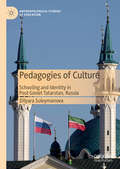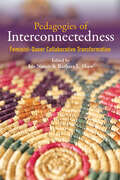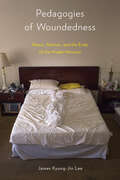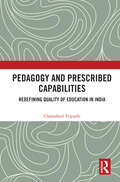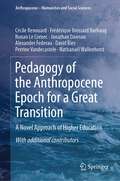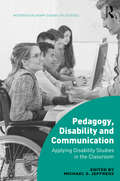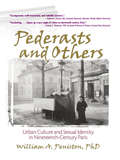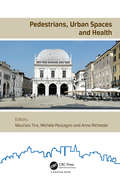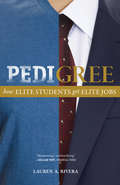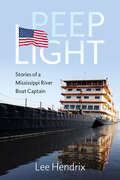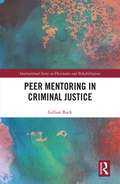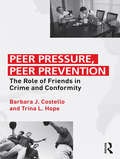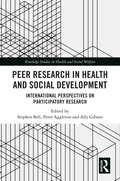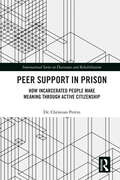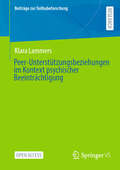- Table View
- List View
Pedagogies of Crossing: Meditations on Feminism, Sexual Politics, Memory, and the Sacred
by M. Jacqui AlexanderM. Jacqui Alexander is one of the most important theorists of transnational feminism working today. Pedagogies of Crossing brings together essays she has written over the past decade, uniting her incisive critiques, which have had such a profound impact on feminist, queer, and critical race theories, with some of her more recent work. In this landmark interdisciplinary volume, Alexander points to a number of critical imperatives made all the more urgent by contemporary manifestations of neoimperialism and neocolonialism. Among these are the need for North American feminism and queer studies to take up transnational frameworks that foreground questions of colonialism, political economy, and racial formation; for a thorough re-conceptualization of modernity to account for the heteronormative regulatory practices of modern state formations; and for feminists to wrestle with the spiritual dimensions of experience and the meaning of sacred subjectivity. In these meditations, Alexander deftly unites large, often contradictory, historical processes across time and space. She focuses on the criminalization of queer communities in both the United States and the Caribbean in ways that prompt us to rethink how modernity invents its own traditions; she juxtaposes the political organizing and consciousness of women workers in global factories in Mexico, the Caribbean, and Canada with the pressing need for those in the academic factory to teach for social justice; she reflects on the limits and failures of liberal pluralism; and she presents original and compelling arguments that show how and why transgenerational memory is an indispensable spiritual practice within differently constituted women-of-color communities as it operates as a powerful antidote to oppression. In this multifaceted, visionary book, Alexander maps the terrain of alternative histories and offers new forms of knowledge with which to mold alternative futures.
Pedagogies of Culture: Schooling and Identity in Post-Soviet Tatarstan, Russia (Anthropological Studies of Education)
by Dilyara SuleymanovaThrough an ethnographic study of schooling in the Republic of Tatarstan, this book explores how competing notions of nationhood and belonging are constructed, articulated and negotiated within educational spaces. Amidst major political and ideological moves toward centralization in Russia under the Putin presidency, this small provincial town in Tatarstan provides a unique case of local attempts to promote and preserve minority languages and cultures through education and schooling. Ultimately, the study reveals that while schooling can be an effective instrument of the state to transform individuals as well as society as a whole, school also encompasses various spaces where the agency of local actors unfolds and official messages are contested. Looking at what happens inside schools and beyond—in classrooms, hallways and playgrounds to private households or local Islamic schools—Dilyara Suleymanova here offers a detailed ethnographic account of the way centrally devised educational policies are being received, negotiated and contested on the ground.
Pedagogies of Interconnectedness: Feminist-Queer Collaborative Transformation (Transformations: Womanist studies)
by Richard Russo Ariella Rotramel Letizia Guglielmo Sharon R. Wesoky Christine Keating Jeremy Hall María Claudia André M. Gabriela Torres Isis Nusair Andrea N. Baldwin Sara Youngblood Gregory Barbara L. Shaw Kimberly Sanchez Misty De Berry Linh U. Hua K. Melchor Hall Rebecca Dawson Luisa Bieri Meryl Altman Danielle M. DeMuth Ayana K. Weekley Montserrat Pérez-Toribio Charlotte Meehan Emily Fairchild Leen Al-Fatafta Carolyn Beer Jordan Alderman Brayden Milam Andrea PutalaA generation of scholar-teacher-activists have moved beyond collaborating in theory to embodying, engaging in, and sharing how they practice their pedagogy. Isis Nusair and Barbara L. Shaw edit essays that link feminist, queer, anti-racist, decolonial, and disability theory and practice while using intersectional, transnational, and interdisciplinary approaches to explore how the personal remains political. The contributors describe ways of building communities within and beyond academic programs and examine what it means to engage in community-building work and action across institutional boundaries. In Part One, the essayists focus on the centrality of community building and reinterpreting bodies of knowledge with students, staff, faculty, and community members. Part Two looks at bringing transnational approaches to feminist collaborations in ways that challenge the classroom’s central place in knowledge production. Part Three explores organic collaborations in and beyond the classroom. A practical and much-needed resource, Pedagogies of Interconnectedness offers cutting-edge ideas for collaboration in pedagogy, education justice, community-based activities, and liberatory worldmaking. Contributors: Jordyn Alderman, Leen Al-Fatafta, Meryl Altman, María Claudia André, Andrea N. Baldwin, Carolyn Beer, Luisa Bieri, Rebecca Dawson, Misty De Berry, Danielle M. DeMuth, Emily Fairchild, Sara Youngblood Gregory, Letizia Guglielmo, Jeremy Hall, K. Melchor Hall, Linh U. Hua, Christine Keating, Charlotte Meehan, Brayden Milam, Isis Nusair, Montserrat Pérez-Toribio, Andrea Putala, Ariella Rotramel, Ann Russo, Kimberly Sanchez, Barbara L. Shaw, M. Gabriela Torres, Ayana K. Weekley, and Sharon R. Wesoky
Pedagogies of Woundedness: Illness, Memoir, and the Ends of the Model Minority (D/C: Dis/color)
by James Kyung-Jin LeeThe pressures Asian Americans feel to be socially and economically exceptional include an unspoken mandate to always be healthy. Nowhere is this more evident than in the expectation for Asian Americans to enter the field of medicine, principally as providers of care rather than those who require care. Pedagogies of Woundedness explores what happens when those considered model minorities critically engage with illness and medicine whether as patients or physicians. James Kyung-Jin Lee considers how popular culture often positions Asian Americans as medical authorities and what that racial characterization means. Addressing the recent trend of writing about sickness, disability, and death, Lee shows how this investment in Asian American health via the model minority is itself a response to older racial forms that characterize Asian American bodies as diseased. Moreover, he pays attention to what happens when academics get sick and how illness becomes both methodology and an archive for scholars. Pedagogies of Woundedness also explores the limits of biomedical “care,” the rise of physician chaplaincy, and the impact of COVID. Throughout his book and these case studies, Lee shows the social, ethical, and political consequences of these common (mis)conceptions that often define Asian Americans in regard to health and illness.
Pedagogy and Prescribed Capabilities: Redefining Quality of Education in India
by Charusheel TripathiThis book questions the validity and reliability of conventional measures of quality education, such as enrolment ratio, retention rates, pupil–teacher ratio, drop-out rates, learning outcomes of children in foundational literacy and arithmetic and availability of infrastructural facilities, henceforth demanding its re-calibration. It moves away from easily commensurable indicators and actively pursues descriptive indicators of quality, which directly focus on educational processes taking place within the classroom and the factors influencing them.By interacting with the two primary stakeholders, i.e. teachers and students, this book draws a link between what is happening within classrooms vis-à-vis the macro-level governmental policies. The strength of the book lies in its methodological approach to understanding whether students and teachers are able to actualize their capabilities, as pledged to them under official educational programmes. By doing so, the author deems to alter the narrative of how quality of education is visualized, hoping that these revelations have developmental implications for not only India but also the entire international community engaging with the questions of ‘what’ and ‘how’ of quality in school education. In a nutshell, the book endeavours to find out how teachers and students fare in terms of realization of their prescribed capabilities.This book would be useful to students, researchers and teachers working in the fields of education, psychology, development studies, policy studies, social work and sociology. It would also be an invaluable companion to policymakers and professionals, from governmental and non-governmental organizations, working in education and social development.
Pedagogy of the Anthropocene Epoch for a Great Transition: A Novel Approach of Higher Education (Anthropocene – Humanities and Social Sciences)
by Jonathan Dawson Nathanaël Wallenhorst Cécile Renouard Frédérique Brossard Børhaug Ronan Le Cornec Alexander Federau David Ries Perrine VandecasteleThis book functions as a practical guide to support teachers and higher education institutions in the construction of their courses and programmes in light of the Anthropocene. It is divided into two complementary parts. The first part lays the theoretical foundations of what is a transition pedagogy and provides a pedagogical framework. It offers practical tools and didactic levers to be used by teachers and institutions to build a truly transformative pedagogy for students, with reference to universities already experimenting such alternative methods. The second part presents an analysis of the pedagogical tools and levers experienced in worldwide institutions, by teachers, as well as philosophers and experts of pedagogy. The authors of this book advocate for an embodied pedagogy which not only gives students access to content but also to ways of thinking and acting in all conscience. A pedagogy of the Anthropocene epoch therefore encourages the mobilization of reason, emotions and senses as well as systemic reflection in the questioning of our lifestyles and the development of transversal skills. Based on internationally recognized research and practical experiences of institutions and teachers all over the western world, this book gathers the knowledge and experience of professors and researchers, coming from a wide variety of disciplines and cultural context. Their reflections have led them to develop a “head-heart-body approach” and a “6 Gates questioning method” to remodel pedagogy. This book is of interest to those working in the education sector.
Pedagogy, Disability and Communication: Applying Disability Studies in the Classroom (Interdisciplinary Disability Studies)
by Michael JeffressResearch has long substantiated the fact that living with a disability creates significant and complex challenges to identity negotiation, the practice of communication, and the development of interpersonal relationships. Furthermore, individuals without disabilities often lack the knowledge and tools to experience self-efficacy in communicating with their differently-abled peers. So how do these challenges translate to the incorporation of disability studies in a classroom context and the need to foster an inclusive environment for differently-abled students? <p><p> Bringing together a range of perspectives from communication and disability studies scholars, this collection provides a theoretical foundation along with practical solutions for the inclusion of disability studies within the everyday curriculum. It examines a variety of aspects of communication studies including interpersonal, intercultural, health, political and business communication as well as ethics, gender and public speaking, offering case study examples and pedagogical strategies as to the best way to approach the subject of disability in education. <p> It will be of interest to students, researchers and educators in communication and disability studies as well as scholars of sociology and social policy, gender studies, public health and pedagogy. It will also appeal to anyone who has wondered how to bring about a greater degree of inclusion and ethics within the classroom.
Pederasts and Others: Urban Culture and Sexual Identity in Nineteenth-Century Paris
by William PenistonExamine how a community of support in Nineteenth-Century Paris became a blueprint for modern sexual identity! A unique social history, Pederasts and Others: Urban Culture and Sexual Identity in Nineteenth-Century Paris is a valuable addition to the growing field of gay and lesbian studies. The book examines the interaction between the city's male homosexual subculture and Parisian authority figures who attempted to maintain political and social order during the early years of the French Third Republic by using laws against public indecency and sexual assault to treat same-sex sexuality as a crime. Faced with a constant cycle of surveillance, harassment, and arrest, the city's gay men survived the hostile urban environment by forming a community of support that had a widespread and lasting influence on the development of modern sexual identities. Pederasts and Others: Urban Culture and Sexual Identity in Nineteenth-Century Paris is based on a statistical analysis of more than 800 working-class and middle-class men who were arrested or investigated by Parisian police between 1873 and 1879. Their stories, presented through long and short case studies, represent nearly 2,000 names recorded by police in "Pederasts and Others," a ledger detailing the arrests of male homosexuals for public offenses against decency and other minor offenses. (The term "pederast" identified those suspected of same-sex sexual activity, not the modern definition that indicates homosexual relations with a minor.) The ledger entries reveal specific habits, attitudes, values, and characteristics about these men that set them apart-the same traits that identified them as part of a community based on their behavior and relationships. Pederasts and Others: Urban Culture and Sexual Identity in Nineteenth-Century Paris examines: the forces of authority the laws regarding same-sex sexual behavior the role of the police the role of the magistrates the role of the doctors the common characteristics of the city's male homosexual subculture the sexual behaviors of the Paris underground the geography of the subculture and takes an expanded look at three case studies: "A Decadent Aristocrat and A Delinquent Boy" "Pederasts, Prostitutes, and Pickpockets" "Love and Death in Gay Paris" Pederasts and Others: Urban Culture and Sexual Identity in Nineteenth-Century Paris also includes tables, appendices, and maps linked to statistical data. The book is an essential resource for historians, sociologists, sexologists, criminologists, and other scholars working in the fields of gay and lesbian studies, urban studies, social and cultural history, and French history.
Pedestrian and Evacuation Dynamics 2012
by Michael Schreckenberg Ulrich Weidmann Uwe KirschThe 6th International Conference on Pedestrian and Evacuation Dynamics (PED2012) showcased research on human locomotion. This book presents the proceedings of PED2012. Humans have walked for eons; our drive to settle the globe began with a walk out of Africa. However, much remains to discover. As the world moves toward sustainability while racing to assess and accommodate climate change, research must provide insight on the physical requirements of walking, the dynamics of pedestrians on the move and more. We must understand, predict and simulate pedestrian behaviour, to avoid dangerous situations, to plan for emergencies, and not least, to make walking more attractive and enjoyable. PED2012 offered 70 presentations and keynote talks as well as 70 poster presentations covering new and improved mathematical models, describing new insights on pedestrian behaviour in normal and emergency cases and presenting research based on sensors and advanced observation methods. These papers offer a starting point for innovative new research, building a strong foundation for the next conference and for future research.
Pedestrians, Urban Spaces and Health: Proceedings of the XXIV International Conference on Living and Walking in Cities (LWC, September 12-13, 2019, Brescia, Italy)
by Maurizio TiraToday, citizens advocate greater environmental sustainability, better services and the improvement of urban quality by promoting safer mobility and health. Addressing these issues, Pedestrians, Urban spaces and Health contains the papers presented at the XXIV International Conference "Living and Walking in Cities" (Brescia, Italy, 12-13 September 2019). The contributions discuss town planning issues, look at best practices and research findings across the broad spectrum of urban and transport planning, with particular attention to the safety of pedestrians in the city. The main topics of the book are: Walking experiences Urban spaces and Redevelopment Healthy cities (as Urban resilience and for Weakest users) Pedestrians, Urban spaces and Health is a powerful plea for a multi-disciplinary and comprehensive approach to urban mobility and planning, and will be of interest to academics, consultants and practitioners interested in these areas.
Pediatric Ethics: Theory and Practice (The International Library of Bioethics #89)
by Nico Nortjé Johan C. BesterThis book assists health care providers to understand the specific interplay of the roles and relationships currently forming the debates in pediatric clinical ethics. It builds on the fact that, unlike adult medical ethics, pediatric ethics begins within an acutely and powerfully experienced dynamic of patient-family-state-physician relationship. The book provides a unique perspective as it interacts with established approaches as well as recent developments in pediatric ethics theory, and then explores these developments further through cases. The book first focuses on setting the stage by introducing a theoretical framework and elaborating how pediatric ethics differ from non-pediatric ethics. It approaches different theoretical frameworks in a critical manner drawing on their strengths and weaknesses. It helps the reader in developing an ability to engage in ethical reasoning and moral deliberation in order to focus on the wellbeing of the child as the main participant in the ethical deliberation, as well as to be able to identify the child’s moral claims. The second section of the book focuses on the practical application of these theoretical frameworks and discusses specific areas pertaining to decision-making. These are: the critically ill child, new and enduring ethical controversies, and social justice at large, the latter of which includes looking at the child’s place in society, access to healthcare, social determinants of health, and vaccinations. With the dynamic changes and challenges pediatric care faces across the globe, as well as the changing face of new technologies, no professional working in the field of pediatrics can afford not to take due note of this resource.
Pediatric Intellectual Disabilities at School: Translating Research into Practice (Pediatric School Psychology)
by Steven R. Shaw Anna M. JankowskaThis book synthesizes the most current evidence-based research and practices on prevention, assessment, intervention, and treatment of pediatric intellectual developmental disabilities. It provides a broad empirical framework for innovative practices and discusses their possible impact on children’s future development, ability to learn, social skills, and quality of life. The book highlights important findings in cognitive and behavioral development for children with such disorders as 22q13 Deletion syndrome (i.e., Phelan McDermid syndrome), Prader-Willi syndrome, Williams syndrome, and sex chromosome disorders (e.g., Klinefelter syndrome) – children often considered untestable, unteachable, and unknowable. In addition, the book includes case studies that emphasize a team approach with physicians, families, school psychologists, and teachers for providing quality research-based psychological, educational, and mental health services. Topics featured in this book include:Up-to-date findings on the causes and symptoms of intellectual disability disorders.Common medical treatments for children with intellectual disabilities.Therapeutic interventions for children with intellectual disabilities.Psychoeducational assessment practices for children requiring special education assistance.Future directions to support people with intellectual disabilities. Pediatric Intellectual Disabilities at School is a must-have resource for researchers, graduate students, and other professionals in child and school psychology, psychiatry, social work, special and general education, public health, and counseling.
Pedigree
by Lauren A. RiveraAmericans are taught to believe that upward mobility is possible for anyone who is willing to work hard, regardless of their social status, yet it is often those from affluent backgrounds who land the best jobs. Pedigree takes readers behind the closed doors of top-tier investment banks, consulting firms, and law firms to reveal the truth about who really gets hired for the nation's highest-paying entry-level jobs, who doesn't, and why.Drawing on scores of in-depth interviews as well as firsthand observation of hiring practices at some of America's most prestigious firms, Lauren Rivera shows how, at every step of the hiring process, the ways that employers define and evaluate merit are strongly skewed to favor job applicants from economically privileged backgrounds. She reveals how decision makers draw from ideas about talent--what it is, what best signals it, and who does (and does not) have it--that are deeply rooted in social class. Displaying the "right stuff" that elite employers are looking for entails considerable amounts of economic, social, and cultural resources on the part of the applicants and their parents.Challenging our most cherished beliefs about college as a great equalizer and the job market as a level playing field, Pedigree exposes the class biases built into American notions about the best and the brightest, and shows how social status plays a significant role in determining who reaches the top of the economic ladder.
Pedigree: How Elite Students get Elite Jobs
by Lauren A. RiveraAmericans are taught to believe that upward mobility is possible for anyone who is willing to work hard, regardless of their social status, yet it is often those from affluent backgrounds who land the best jobs. Pedigree takes readers behind the closed doors of top-tier investment banks, consulting firms, and law firms to reveal the truth about who really gets hired for the nation’s highest-paying entry-level jobs, who doesn’t, and why. Drawing on scores of in-depth interviews as well as firsthand observation of hiring practices at some of America’s most prestigious firms, Lauren Rivera shows how, at every step of the hiring process, the ways that employers define and evaluate merit are strongly skewed to favor job applicants from economically privileged backgrounds. She reveals how decision makers draw from ideas about talent—what it is, what best signals it, and who does (and does not) have it—that are deeply rooted in social class. Displaying the "right stuff" that elite employers are looking for entails considerable amounts of economic, social, and cultural resources on the part of the applicants and their parents. Challenging our most cherished beliefs about college as a great equalizer and the job market as a level playing field, Pedigree exposes the class biases built into American notions about the best and the brightest, and shows how social status plays a significant role in determining who reaches the top of the economic ladder.
Peep Light: Stories of a Mississippi River Boat Captain
by Lee HendrixMost people only consider the Mississippi River when they cross it or when it inconveniently abandons its banks. But every year, millions of tons of cargo are transported by towboats on the river. In Peep Light: Stories of a Mississippi River Boat Captain, Captain Lee Hendrix provides unique insight on people who work and live on and near the Mississippi River. Hendrix, formerly a pilot for the Delta Queen Steamboat Co., has worked on the Mississippi for fifty years, first as a towboat deckhand in 1972 and eventually as a pilot of towboats and passenger vessels. In 2014, Hendrix became captain of the towboat Mississippi with the US Army Corps of Engineers, then he later retired to return to passenger vessels. For Hendrix and others like him, he is at home on the river, living and dining with the same people they work with, working with familiar faces for years at a time and yet meeting new people every day.Demonstrating a fascination not only with the river but also with the passions and dreams of those who live and work on it, these stories range from personal reflections on aging, experiencing one’s first night on the river and the complex emotions that come with it, working on the deck, promotion to pilot, the characters working aboard these boats, and the history of the river itself. Peep Light unites humans with the river through engaging storytelling and sheds light on Hendrix’s rare experience along one of the most powerful and important waterways in the world.
Peer Mentoring in Criminal Justice (International Series on Desistance and Rehabilitation)
by Gillian BuckPeer mentoring is an increasingly popular criminal justice intervention in custodial and community settings. Peer mentors are community members, often with lived experiences of criminal justice, who work or volunteer to help people in rehabilitative settings. Despite the growth of peer mentoring internationally, remarkably little research has been done in this field. This book offers the first in-depth analysis of peer mentoring in criminal justice. Drawing upon a rigorous ethnographic study of multiple community organisations in England, it identifies key features of criminal justice peer mentoring. Findings result from interviews with people delivering and using services and observations of practice. Peer Mentoring in Criminal Justice reveals a diverse practice, which can involve one-to-one sessions, group work or more informal leisure activities. Despite diversity, five dominant themes are uncovered. These include Identity, which is deployed to inspire change and elevate knowledge based on lived experiences; Agency, or a sense of self-direction, which emerges through dialogue between peers; Values or core conditions, including caring, listening and taking small steps; Change, which can be a terrifying and difficult struggle, yet can be mediated by mentors; and Power, which is at play within mentoring relationships and within the organisations, contexts and ideologies that surround peer mentoring. Peer mentoring offers mentors a practical opportunity to develop confidence, skills and hope for the future, whilst offering inspiration, care, empathy and practical support to others. Written in a clear and direct style this book will appeal to students and scholars in criminology, sociology, cultural studies, social theory and those interested in learning about the social effects of peer mentoring.
Peer Pedagogies on Digital Platforms: Learning with Minecraft Let's Play Videos (Learning in Large-Scale Environments)
by Michael DezuanniHow a popular entertainment genre on YouTube--Let's Play videos created by Minecraft players--offers opportunities for children to learn from their peers.Every day millions of children around the world watch video gameplay on YouTube in the form of a popular entertainment genre known as Let's Play videos. These videos, which present a player's gameplay and commentary, offer children opportunities for interaction and learning not available in traditional television viewing or solo video gameplay. In this book, Michael Dezuanni examines why Let's Play videos are so appealing to children, looking in particular at videos of Minecraft gameplay. He finds that a significant aspect of the popularity of these videos is the opportunity for knowledge and skill exchange.
Peer Pressure, Peer Prevention: The Role of Friends in Crime and Conformity
by Barbara J. Costello Trina L. HopeCriminological research has largely neglected the possibility that positive peer influence is a potentially powerful source of social control. Quantitative methods tease out cause, effect, and spuriousness in the relationship between peer delinquency and personal delinquency, but these methods do little or nothing to reveal how and why peers might influence each other toward--or away from--deviance. Costello and Hope take a first step toward uncovering the mechanisms of peer influence, drawing on quantitative and qualitative data collected from two convenience samples of university students. Their quantitative analyses showed that positive peer influence occurs most frequently among those who associate with the most deviant peers and self-report the most deviance, contrary to predictions drawn from social learning theories. Their qualitative data revealed a variety of methods of negative influence, including encouraging deviant behavior for others' amusement, a motive for peer influence never before reported in the literature.
Peer Relationships at School: New Perspectives on Migration and Diversity
by Emma SoyeAvailable Open Access digitally under CC-BY-NC-ND licence. It is increasingly recognized that ethnonational frameworks are inadequate when examining the complexity of social life in contexts of migration and diversity. This book draws on ethnographic research in two UK secondary schools, considering the shifting roles of migration status, language, ethnicity, religion and precarity in young people’s peer relationships. The book challenges culturalist understandings of social cohesion, highlighting the divisive impacts of neoliberalism, from pervasive temporariness and domestic abuse to technologization and neighbourhood violence. Using Martin Buber’s relational model, the book explores the interplay of ‘I-It’ boundary-making with reciprocal ‘I-Thou’ encounters, pointing to the creative power of these encounters to subvert, reimagine and even transform social difference. The author provides a pragmatic and ultimately hopeful view of the dynamics of diversity in everyday life, offering valuable insights for social policy and practice.
Peer Research in Health and Social Development: International Perspectives on Participatory Research (Routledge Studies in Health and Social Welfare)
by Stephen Bell, Peter Aggleton and Ally GibsonPeer research is increasingly used in international academic, policy and practice environments. It engages members of a group or social network as trusted members of a research team working in communities and settings they are familiar with. Critics, however, point to methodological concerns with peer research. These include the extent to which peer researchers genuinely represent the populations under study; data confidentiality; the emotional burden of enquiring into sensitive issues peers may experience in their own lives; and the reliability and credibility of data collected by people who do not have academic training. The book seeks to counter the marginalisation of research experience and skills derived from close relationships with people and communities, while reflecting critically on the strengths and limitations of peer research. Chapters by a wide range of international contributors illustrate the potential of peer research to facilitate an in-depth understanding of health and social development issues and enhance policy and practice. This interdisciplinary book provides students and professionals working in health, social science and development studies with a thorough grounding in this new style of research. It will appeal to those interested in research and evaluation; sexual health and public health; mental health, disability and social care; gender and sexuality; conservation and environmental management; migration and citizenship studies; humanitarian issues; and international development.
Peer Support Services Reaching People with Schizophrenia: Considerations for Research and Practice
by Megan EvansMany mental health providers are seeking guidance in designing and improving peer support programs for people with mental illnesses. However, the evidence base in this area is limited by lack of consensus on the core components of peer support. This research provides a comprehensive, nuanced view of peer support reaching people with schizophrenia. Results of a realist review of 355 sources and interviews with experts in the field are presented. Realist review is an approach to evidence synthesis that asks, ‘What works, for whom, and in what circumstances?’ Results include a typology of key functions of peer support (e.g., being there, linkage to clinical care and community resources, systems advocacy, ongoing support), documented benefits (e.g., decreased acute care utilization, increased recovery), and implementation recommendations (e.g., critical mass of peer workers, supportive infrastructure, an organizational recovery orientation). The book is intended for program planners, managers, and researchers.
Peer Support in Prison: How Incarcerated People make Meaning through Active Citizenship (International Series on Desistance and Rehabilitation)
by Christian PerrinThis book explores the profound impact of peer support within the bleak landscape of incarceration. In a system bereft of opportunities for personal growth, the narratives within these pages reveal how individuals who have committed offences rebuild their lives by ‘giving back’ and establishing meaningful connections with their fellow inmates.Peer Support in Prison draws on rich phenomenological interviews conducted with prisoners who assumed altruistic social roles while serving time. In doing so, it highlights the value of peer support in fostering hope, making meaning, and cultivating prosocial identities. By adopting empathic and mutually supportive roles within the prison community, individuals forge a pathway to a more meaningful future, defying unfavourable odds. The text unfolds to demonstrate that, even for those denigrated and rejected as ‘evil’, change is possible when motivated by principles of compassion, reciprocity, and connectedness.This book attests to the adaptability of humans, offering a unique perspective on how incarcerated individuals can find redemption, build trust, and reconstruct their lives through the transformative power of generativity and active citizenship. This has great implications for a stagnant carceral system which does not work as a restorative mechanism. Within the frame of ‘generative justice’, the findings from this book offer hopeful alternatives to the cruel hegemony of prison.
Peer to Peer and the Music Industry: The Criminalization of Sharing (Published in association with Theory, Culture & Society)
by Matthew DavidHave the music and movie industries lost the battle to criminalize downloading? This penetrating and informative book provides readers with the perfect systematic critical guide to the file-sharing phenomenon. Combining inter-disciplinary resources from sociology, history, media and communication studies and cultural studies, David unpacks the economics, psychology and philosophy of file-sharing. The book carefully situates the reader in a field of relevant approaches including Network Society Theory, Post-structuralism and ethnographic research. It uses this to launch into a fascinating enquiry into: * the rise of file-sharing, * the challenge to intellectual property law posed by new technologies of communication, * the social psychology of cyber crime * and the response of the mass media and multi-national corporations. The book concludes with a balanced, eye-opening assessment of alternative cultural modes of participation and their relationship to cultural capitalism. This is a landmark work in the sociology of popular culture and cultural criminology. It fuses a deep knowledge of the music industry and the new technologies of mass communication with a powerful perspective on how multinational corporations seek to monopolize markets, how international and state agencies defend property, while a global multitude undermine and/or reinvent both.
Peer-Unterstützungsbeziehungen im Kontext psychischer Beeinträchtigung (Beiträge zur Teilhabeforschung)
by Klara LammersDieses Open-Access-Buch schafft durch ein qualitatives Forschungsvorgehen im Sinne der Grounded Theory Methodologie einen empirischen Zugang zur Perspektive von Peer-Begleiter*innen auf Unterstützungsangebote im Kontext psychischer Beeinträchtigung. Im Fokus der in diesem Zuge entwickelten gegenstandsverankerten Theorie steht die Peer-Beziehung zwischen Peer-Begleiter*innen und Nutzer*innen als spezifische Ausprägung einer Unterstützungsbeziehung. Die Ergebnisse dieser Arbeit deuten darauf hin, dass diese als komplexe Form der Beziehungsgestaltung verstanden werden kann, da sie von einer Gleichzeitigkeit drei unterschiedlicher Positionierungen der Peer-Begleiter*innen gegenüber den Nutzer*innen geprägt ist: erstens als Selbst-Betroffene, zweitens als Unterstützer*innen und drittens als organisationale Akteur*innen. Aus dem Zusammenwirken dieser Aspekte resultierende Spannungsfelder kennzeichnen die entstehenden Peer-Beziehungen und stellen die Anforderung an Peer-Begleiter*innen, im praktischen Handeln einen Umgang damit zu finden.
Pegasus
by Marianna MayerRetells how Bellerophon, son of the king of Corinth, secures the help of the winged horse Pegasus in order to fight the monstrous Chimera.

